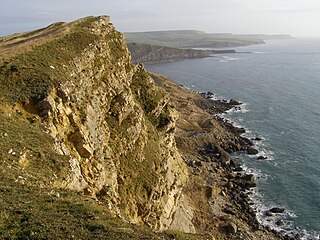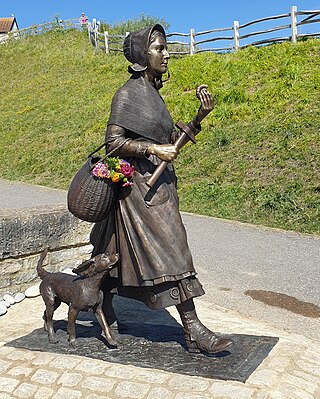
Dorset is a ceremonial county in South West England. It is bordered by Somerset to the north-west, Wiltshire to the north and the north-east, Hampshire to the east, the Isle of Wight across the Solent to the south-east, the English Channel to the south, and Devon to the west. The largest settlement is Bournemouth, and the county town is Dorchester.

Mary Anning was an English fossil collector, dealer, and palaeontologist. She became known internationally for her discoveries in Jurassic marine fossil beds in the cliffs along the English Channel at Lyme Regis in the county of Dorset, Southwest England. Anning's findings contributed to changes in scientific thinking about prehistoric life and the history of the Earth.

The River Axe is a 22-mile (35 km) long river in the counties of Dorset, Somerset and Devon, in the south-west of England. It rises in Dorset and flows south to Lyme Bay which it enters through the Axe Estuary in Devon. It is a shallow, non-navigable river, although its mouth at Seaton has some boating activity. The name Axe derives from a Common Brittonic word meaning "abounding in fish", and is cognate with pysg, the Welsh word for fish.

Lyme Regis is a town in west Dorset, England, 25 miles (40 km) west of Dorchester and east of Exeter. Sometimes dubbed the "Pearl of Dorset", it lies by the English Channel at the Dorset–Devon border. It has noted fossils in cliffs and beaches on the Jurassic Coast, a World Heritage Site and heritage coast. The harbour wall, known as The Cobb, appears in Jane Austen's novel Persuasion, the John Fowles novel The French Lieutenant's Woman and the 1981 film of that name, partly shot in the town.

The Jurassic Coast is a World Heritage Site on the English Channel coast of southern England. It stretches from Exmouth in East Devon to Studland Bay in Dorset, a distance of about 96 miles (154 km), and was inscribed on the World Heritage List in mid-December 2001.

Bridport is a market town in Dorset, England, 1+1⁄2 miles (2.4 km) inland from the English Channel near the confluence of the River Brit and its tributary the Asker. Its origins are Saxon and it has a long history as a rope-making centre. On the coast and within the town's boundary is West Bay, a small fishing harbour also known as Bridport Harbour.

The Royal National Lifeboat Institution (RNLI) is the largest of the lifeboat services operating around the coasts of the United Kingdom, the Republic of Ireland, the Channel Islands, and the Isle of Man, as well as on some inland waterways.

Chideock is a village and civil parish in south west Dorset, England, situated close to the English Channel between Bridport and Lyme Regis. Dorset County Council's 2013 estimate of the parish population is 550.

Cadgwith is a village and fishing port in Cornwall, England, United Kingdom. It is on the Lizard Peninsula between The Lizard and Coverack. It is in the civil parish of Grade Ruan.
The Pink Pippos of Portland is a 2002 children's storybook written by Sandra Fretwell. The book was adapted for the stage by Sandra’s daughter, Sophie Fretwell in 2020, and performed at the Royal Manor Theatre, Fortuneswell in July 2021, before going on tour with an all-star cast of Dan Almond, Laura Urquhart, Ethan Skillman, Ian Neale, Dan Babei and Verity Jefferis from August to October 2022.
Mark Ernest Hix is an English chef and restaurateur whose traditional English menus often feature foraged and local foods. Prior to the COVID-19 pandemic, Hix was based in London, but announced in January 2021 that he would be relocating to Dorset permanently after five of his restaurants were put into administration.
Water Polo has a long and distinguished history in Dorset, and is arguably the location for the world's first ever structured Water Polo match - held in 1876 off Bournemouth Pier.

Weymouth Lifeboat Station is the base for Royal National Lifeboat Institution (RNLI) search and rescue operations at Weymouth in Dorset, England. The first lifeboat was stationed in the town in 1869. Since 2002 it has operated a Severn-class all-weather lifeboat (ALB) and an Atlantic 75 inshore lifeboat (ILB).

Exmouth Lifeboat Station is the base for Royal National Lifeboat Institution (RNLI) search and rescue operations at Exmouth, Devon, England. The first lifeboat was stationed in the town in 1803 and the present station was opened in 2009. In 2014 a new Shannon-class 25-knot all-weather boat (ALB) went on station. Also operated is a D-class (IB1) inshore lifeboat (ILB).

Bridport Arts Centre is an arts centre in Bridport, Dorset, England. Founded in 1973, it is housed in and around a 19th-century, Grade II listed building, formerly known as the Wesleyan Methodist Chapel. The complex includes the Marlow Theatre, the Allsop Gallery and a cinema.

Aberystwyth Sea2shore Food Festival is an annual food festival held at Aberystwyth, Ceredigion over three days during October.

Staithes and Runswick Lifeboat Station is a Royal National Lifeboat Institution (RNLI) lifeboat station based in the village of Staithes, North Yorkshire, England. The station was first opened in 1875 but has been closed for two periods between then and the 21st century due to a decline in the fishing industry and the ability to supply people to crew the lifeboat. It is now host to an Inshore Lifeboat (ILB).

The Jurassic Coaster is a bus service operated by the Weymouth branch of First Hampshire & Dorset, running around the Jurassic coastline of the county of Dorset. It features five routes, stretching from Axminster in the west to Poole in the east, with one of the routes in TripAdvisor's 2018 poll of most scenic bus routes coming in 12th place.

The River Lym or River Lim is a short river, some 5 km in length, that flows through the Devon-Dorset border. It rises from multiple springs at Raymond's Hill, near the village of Uplyme in East Devon, and flows southeasterly through Dorset, into the English Channel via Lyme Bay in the town of Lyme Regis, Dorset. The river falls over 200 metres from its source.

The Statue of Mary Anning is a bronze sculpture of the paleontologist Mary Anning in Lyme Regis.


















